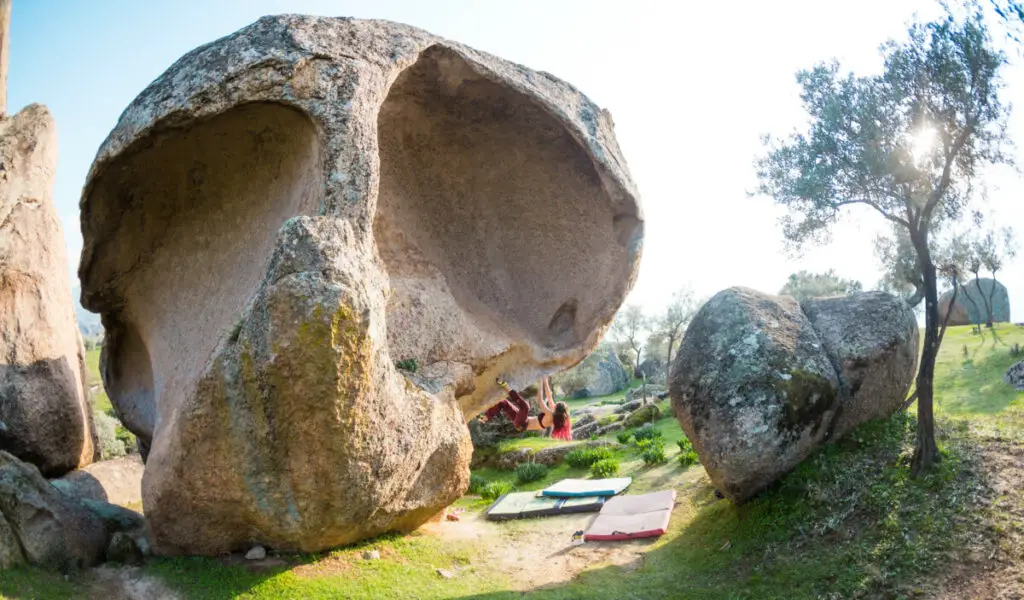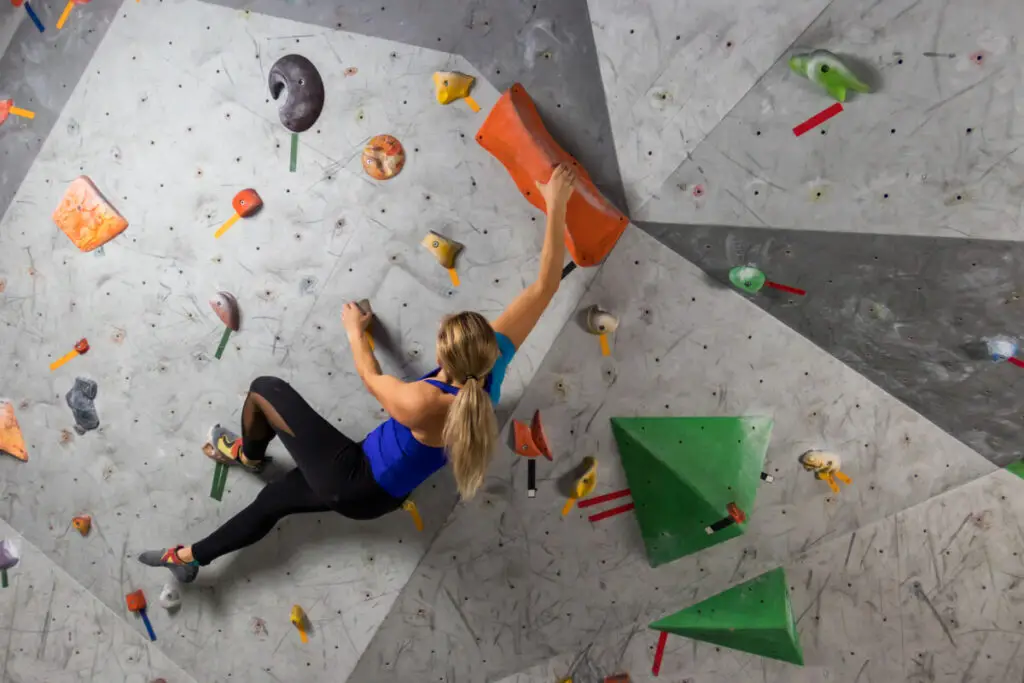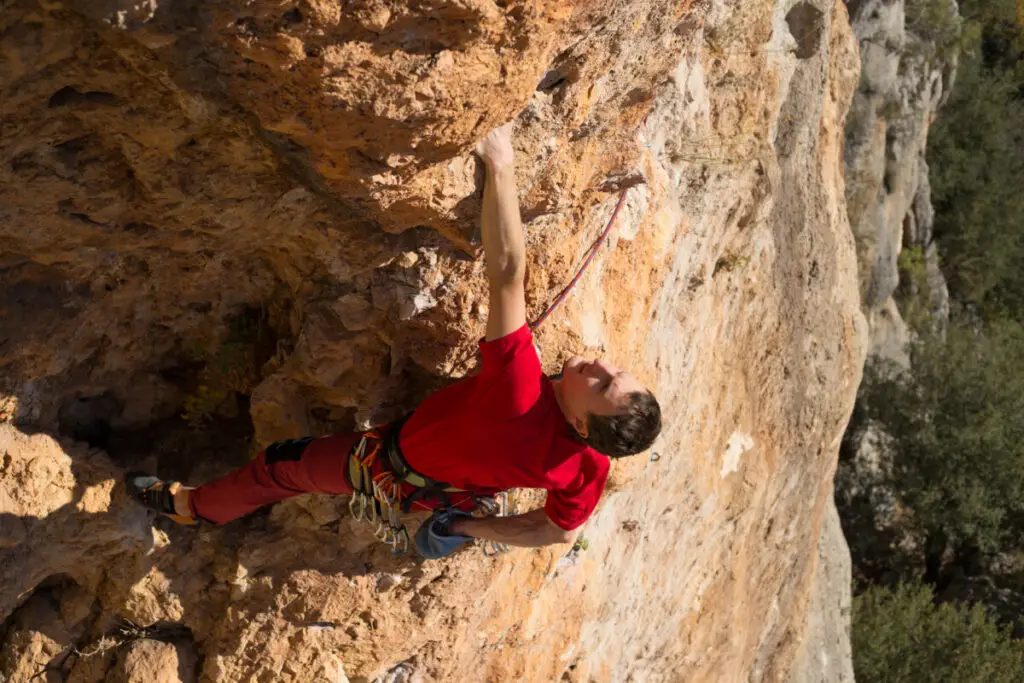
It may seem like sports that involve climbing up a rock are all considered one thing. However, bouldering and rock climbing are different sports with different practices. So, what are the differences between rock climbing and bouldering?
Bouldering is climbing 12 to 15 feet without a rope or harness. Rock climbing is climbing over 15 feet using a rope and harness. Bouldering requires less equipment and can be done alone. Rock climbing builds better endurance and has more indoor facilities and outdoor climbs dedicated to it.
There are many differences between bouldering and climbing, including ideal locations, equipment, difficulty, and safety. There is a lot to learn about these two different sports.
Location
One of the main differences between bouldering and rock climbing is the kinds of locations at which you can do either one. Bouldering and rock climbing have different requirements for the climbs that you will complete.
Outdoor
Outdoor bouldering climbs tend to be large boulders (that’s where the name comes from). They are usually between 12 and 15 feet high. Some bouldering climbs may have more handhold surfaces that slant away from you. However, some of the more difficult ones involve faces (a flat and vertical surface), slabs (a flat surface that is angled toward you), and even overhangs (a rock surface that is horizontal and hangs over your head). The goal is to make it to the top of the boulder without falling off.
Outdoor rock climbing is usually done on a cliff face. They are typically vertical and are higher than 15 feet, but tend to be at least 30 feet. Rock climbing takes longer because you have more distance to climb, and it requires more endurance than raw power because you are climbing for longer.
It is typically easier to find rock climbing climbs than it is to find bouldering climbs. Rock climbing is more popular than bouldering, so you are more likely to find someone who will tell you about a good rock climbing spot near you than a good bouldering spot.
Indoor
There are often indoor bouldering climbs available at rock climbing facilities. If there is a shorter rock climbing wall with no harnesses and a pad beneath it to catch people who fall off, that is a bouldering wall. Many facilities will have them, though some patrons consider them the rock climbing walls for people to climb on as they wait for a larger one to open up. On the contrary, they are actually indoor bouldering climbs. These bouldering climbs tend to be pretty easy, and it may be hard to find an advanced indoor bouldering climb.
Indoor rock climbing walls are all over the place. There are facilities dedicated to rock climbing or rec-centers that have rock climbing walls available along with all their other options. Indoor rock climbing walls will often have a system for one person belaying another, usually with some weight or age requirements for the one doing the belaying. Other facilities will have an auto belay that will slowly lower you using an elastic rope. Many facilities will assign difficulties to different walls, so it will be easier to tell whether a wall is easier or more difficult.
Equipment

Bouldering requires less equipment than rock climbing does. For bouldering, you will need climbing shoes and a pad to fall onto. If you are climbing indoors, you won’t need to bring a pad; in fact, easier indoor climbs can be done in regular tennis shoes.
When climbing outdoors, there are some other types of equipment that aren’t necessary but are good to have, including chalk, a brush, athletic tape, and a helmet. Chalk will add friction to your hands so you won’t slip as much when you climb. A brush can be used to clean out dirty or greasy handholds. Athletic tape protects your fingers, which is important if you go bouldering frequently. Many climbers will skip a helmet, but it will provide some extra safety, especially if you miss the pad when you fall.
Many indoor rock climbing facilities don’t require any extra equipment. You can just show up with a pair of tennis shoes, and they will provide the harness and ropes.
When rock climbing outside, you will need to bring your own equipment. This includes a pair of climbing shoes, chalk, a harness, and climbing rope (don’t just buy regular rope). You should purchase this equipment brand new and make sure to replace it after a while.
You’ll need to go rock climbing with someone else so that they can belay you; this means that they will keep the climbing rope tight enough that it will catch you if and when you fall. One of you should have some climbing experience so that you know what to do.
If you don’t want to go rock climbing with someone else or don’t have anyone else to go with, there is extra equipment that you can buy to help you to belay yourself, such as a personal anchor system or a daisy chain. Make sure you are familiar with how to use this equipment before you start climbing, and make sure that it is new.
Difficulty
In regards to the difficulty of bouldering and rock climbing, one is not necessarily harder than the other. They both require different strengths and have varying difficulties of climbs.
Bouldering usually involves a shorter and quicker burst of strength that you use to get yourself to the top of the boulder. It takes raw strength and planned movements.
Rock climbing is more about endurance. You have to keep going carefully and thoughtfully consider your next moves. It takes longer and helps develop your ability to hold on for longer.
Both rock climbing and bouldering require strength and the ability to plan and figure out where to put your hands and feet. They take skill, strength, and practice.
Some bouldering climbs are going to be easier and some will be harder. Some rock climbs will be easier and some will be harder. It is impossible to compare the difficulty of the two sports because some bouldering climbs will be more difficult than some rock climbs, and some rock climbs will be more difficult than some bouldering climbs.
Safety

When you climb high up on a rock, trying to grip natural, often small, handholds in the stone, there is usually a good amount of risk involved. Both rock climbing and bouldering involve risks.
When bouldering, you are climbing without restraints. You trust a mat to catch you when you fall. You might put the mat in the wrong spot and fall onto the ground. A mat might have a rock underneath that could injure you if you land on it. There is a lot that can go wrong when you are bouldering.
Rock climbing has a harness and a rope involved, so if you fall you should be caught. However, if something goes wrong, you are much higher off the ground. If your belay partner messes up or if your equipment is faulty, you can fall and be seriously injured. The injury you would sustain has the potential to be much worse than if you fall when bouldering.
When bouldering, you are more likely to be injured, especially as a beginner. However, when rock climbing, the injuries you would sustain would probably be much worse. Both sports have their safety risks.
Pros and Cons of Bouldering
It is impossible for me to tell you whether you should do bouldering or rock climbing. However, the pros and cons of each can help you to decide whether bouldering or rock climbing would be a better fit for you.
Pros of Bouldering
Bouldering requires less equipment. This means that there are only a few things that you need to lug out into nature to get them to your bouldering location. It also means that you don’t have to spend as much money purchasing equipment.
Bouldering also doesn’t require another person to come with you. Bouldering with someone outdoors is a good idea so they can tell you if you are in the right spot to land on the mat and move it if need be. However, you don’t necessarily need someone to help you when bouldering. This way, you don’t need to coordinate timing with someone else, which allows you to be as antisocial as you want.
Cons of Bouldering
It is harder to find indoor and outdoor climbs for bouldering. Bouldering is not as popular as rock climbing is, so fewer people are actively looking for bouldering climbs to do, and there are few indoor facilities with a variety of bouldering climbs. You will probably be able to find bouldering climbs near you, but it is harder to find ones that will fit your skill level as you progress from a beginner to an expert.
When you fall off when rock climbing, the rope catches you and you don’t fall very far. You can usually pick up where you left off. When you fall off a bouldering climb, you fall all the way to the bottom. This means you have to start over. If you are a beginner, you will probably fall a lot. This can become tedious because you have to constantly get back up and try again.
Bouldering mats tend to be very bulky and difficult to transport. You have to haul a large, heavy mat to a rock so that you can fall onto it. There is more rock climbing equipment, but rock climbing equipment often has easy ways to store and transport it.
Pros and Cons of Climbing

Pros of Climbing
Rock climbs are harder to find than bouldering climbs. Rock climbing is more popular, so outdoor climbs are going to be easier to find. There is also going to be more information about their difficulties, so you can more easily find a climb that fits your skill level. There are more indoor facilities for rock climbing than bouldering. Though there are many indoor bouldering climbs at rock climbing facilities, they are usually fairly easy and don’t have as much variety.
If you fall off the rock climbing wall, you will be caught by the rope. You will then be able to pick up where you left off. You will be able to complete climbs without starting all over again, and it will be much less tedious and discouraging for a beginner who falls a lot.
Rock climbing is very good at teaching endurance. Rather than quick bursts of strength, it helps you get better at holding on for longer and continuing on. You are also able to take it more slowly and think things through. Some bouldering climbs require you to move quickly and use your momentum, giving you little time to consider what to do next.
Cons of Climbing
You need to purchase more equipment for rock climbing. This will cost more money and require you to keep track of more things. With bouldering, you generally just need the mat and a good pair of shoes. There is a lot more that you need for rock climbing.
When you go rock climbing, you need to bring a person with you. That means you need to work around two different schedules and get equipment for more than one person. If you want to spend some peaceful time alone in nature, it may be harder to do that when rock climbing. There are pieces of equipment you can buy so that you can rock climb by yourself, but these require you to spend more money and learn how to use them properly.
Because rock climbing is more popular, there are going to be more people going out and rock climbing. Popular outdoor climbs or indoor facilities are going to be crowded. You may need to wait your turn, and it won’t be a very peaceful experience. You also may need to maneuver around other climbers.
There are pros and cons to bouldering and climbing. Just consider which ones are most important to you and decide which one fits your need better. Make sure to stay safe and have fun!

